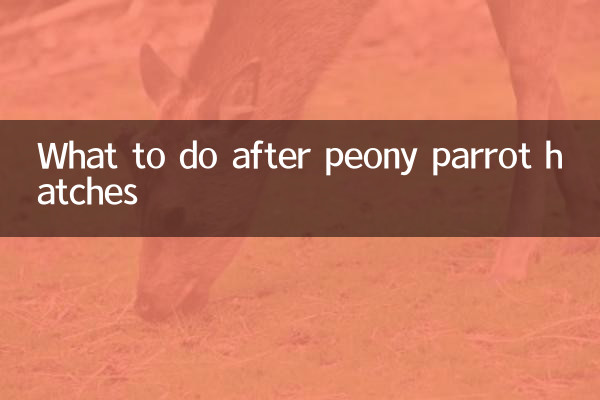What to do after peony parrot hatches
The peony parrot is a lively and cute pet bird that is loved by bird lovers. The care of your parrot after hatching is key and directly affects its health and growth. This article will introduce in detail how to raise peony parrots after hatching, and provide structured data to help you better care for the young birds.
1. Basic care for peony parrots after hatching

1.temperature control: Young birds are very sensitive to temperature and need to keep the ambient temperature between 30-35°C. You can use a heat preservation lamp or heating pad to assist.
2.Feeding frequency: Young birds need small and frequent meals. It is recommended to feed them every 2-3 hours. Special parrot milk powder can be used.
3.health management: Clean the nest box regularly to avoid bacterial growth. The feathers and beaks of young birds need to be kept clean.
| care items | Specific operations |
|---|---|
| temperature control | 30-35℃, use insulation equipment |
| Feeding frequency | Parrot milk powder every 2-3 hours |
| health management | Clean nest boxes daily and keep them dry |
2. Diet management of young peony parrots
1.Milk powder selection: Use milk powder specially formulated for parrots and avoid using human milk powder or dog and cat milk powder.
2.Feeding method: Feed slowly with a special feeding syringe or spoon to avoid choking.
3.Hydration: Young birds need an appropriate amount of warm water, and a small amount of electrolytes can be added to enhance their physical fitness.
| Diet items | Things to note |
|---|---|
| Milk powder selection | Special milk powder for parrots, avoid milk powder for other animals |
| Feeding method | Feed slowly to avoid choking |
| Hydration | Warm water + a small amount of electrolytes |
3. Health monitoring of young peony parrots
1.weight record: Weigh yourself every day to ensure steady weight gain.
2.stool observation: Healthy baby bird feces should be solid, normal in color, and without abnormal odor.
3.behavioral observation: Being lively and shouting loudly is a sign of health. If you feel depressed, you need to seek medical attention in time.
| Monitoring items | health standards |
|---|---|
| weight record | Gain 1-2 grams daily |
| stool observation | Solid, no unusual color or odor |
| behavioral observation | Lively and active, loud barking |
4. Growth stages of peony parrot chicks
1.0-1 week: Completely dependent on artificial feeding and needs to maintain a constant temperature environment.
2.1-3 weeks: When feathers begin to grow, the temperature can be gradually lowered to about 25°C.
3.3 weeks later: Try offering soft foods such as soaked millet or fruit puree.
| growth stage | Feeding focus |
|---|---|
| 0-1 week | Artificial feeding, constant temperature 30-35℃ |
| 1-3 weeks | Gradually cool down to 25℃ and observe the growth of feathers |
| 3 weeks later | Try soft foods such as soaked millet |
5. Common problems and solutions
1.Young bird refuses to eat: Check whether the temperature of the milk powder is appropriate, or consult a veterinarian to adjust the diet.
2.weight loss: It may be a digestive problem and the milk powder concentration or feeding frequency needs to be adjusted.
3.stunted feather development: Check whether the nutrition is balanced and supplement vitamins and minerals.
| question | Solution |
|---|---|
| Young bird refuses to eat | Adjust milk powder temperature or change brand |
| weight loss | Check digestion and adjust diet |
| stunted feather development | Vitamin and mineral supplements |
Through the above methods, you can better take care of your peony parrot chicks and ensure their healthy growth. If there are any abnormalities, it is recommended to consult a professional veterinarian in time.

check the details

check the details